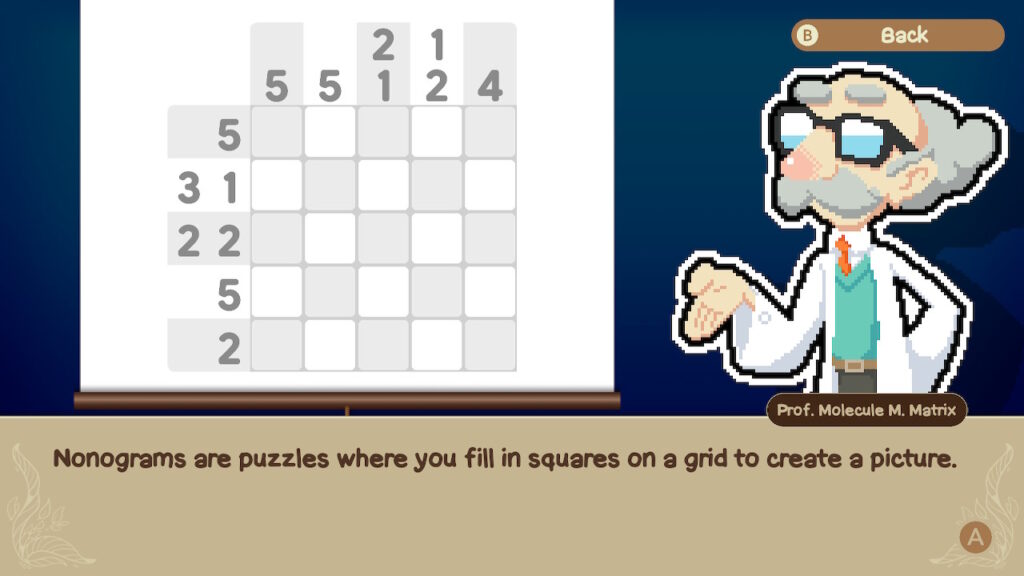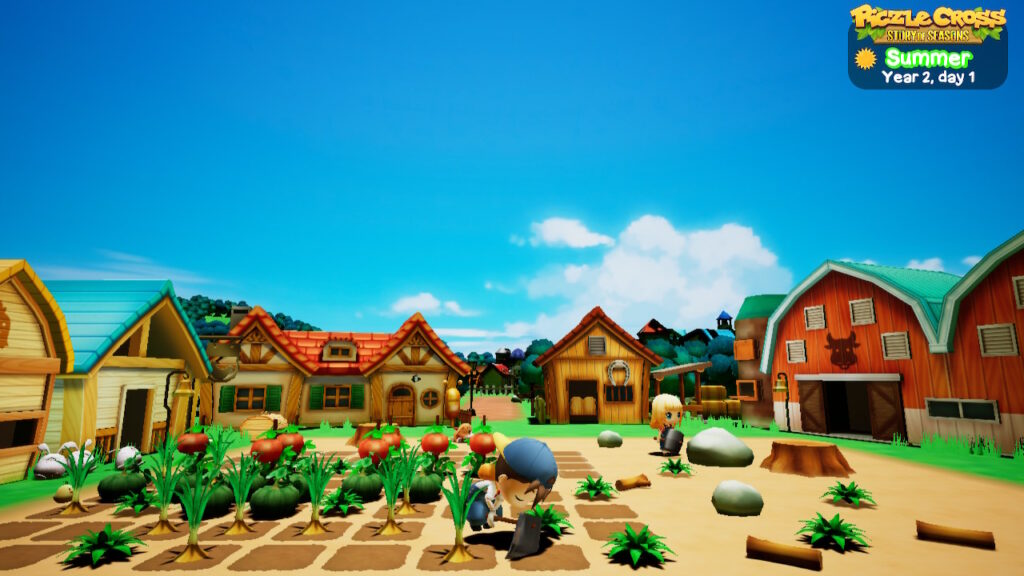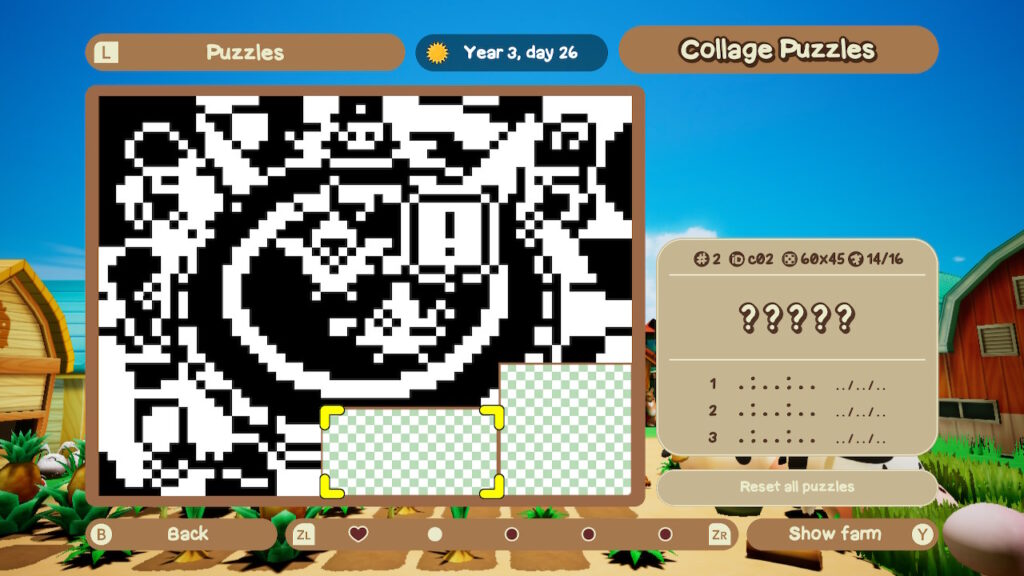Piczle Cross: Story of Seasons is a nonogram puzzle collection themed around the long-running Bokujō Monogatari series, or as it is known in the west, Story of Seasons. By using deductive reasoning to solve nonogram puzzles, I unveil stylized, pixelated images of characters, objects, buildings, and scenes from the farm life simulation series. These images are added to an almanac encompassing some of Story of Seasons’ most recent and popular releases. My progress is also reflected in a farm which grows with life and activity across multiple in-game years, adding new crops and animals as I complete the puzzles which hide them. This is a simple and pure fanservice videogame aimed at Story of Seasons veterans containing more than 350 individual puzzles.

A nonogram puzzle is a grid with number clues marked along its edges. By deducing the solutions to the number clues, I fill in squares on the grid. When every number clue is correctly solved, a pixel art image is revealed. Each number clue reveals how many squares in its row should be filled in; if a row is ten squares wide and the number clue is ten, then all ten squares should be filled in. When a row contains multiple clues, there is always at least one blank space between filled squares; if that ten-square row has number clues of five and four, then five squares should be filled in, then one left blank, then four more, for a total of ten squares.
Where nonogram puzzle solving gets complicated is that provided number clues usually do not perfectly fit into their row. In these cases it is possible to deduce only a few squares in the row, or often none at all. By filling in squares in adjacent rows, I gain enough information to deduce solutions to number clues that can’t immediately be solved. With every deduction I make, an image unveils more of itself, one pixel at a time. If I correctly solve every number clue, then an image is revealed and the puzzle is solved.

Do not be frustrated if this explanation is difficult to follow. Nonogram puzzles are overwhelming when described in writing. They make much more sense when the player actually sits down and interacts with them. A good nonogram puzzle collection will have a strong, slow-paced tutorial that walks new players through every step of the process, including some of the more advanced concepts. Even more useful time-saving methods will reveal themselves to a player who immerses themselves in hundreds of puzzles as they internalize the rules and absorb repeating patterns and concepts.
Piczle Cross: Story of Seasons frustratingly lacks such a strong, slow-paced tutorial. Professor Molecule M. Matrix, a recurring mentor character from the Piczle series of puzzle videogames, appears on a farmhouse television screen to explain nonogram puzzle solving when I first begin playing. His tutorial is rushed and perfunctory. I am an experienced nonogram puzzle solver and am able to brush past Matrix’s explanation with no friction. Players new to nonograms will find this collection a mystifying and frustrating introduction. This is in part to how quickly the puzzles ramp up in size and corresponding difficulty. In its eagerness to get to larger and more detailed pictures, Piczle Cross: Story of Seasons rushes from beginner-friendly 5×5 boards to medium-difficulty 15×15 boards in less than thirty puzzles.

An advantage in software-based nonogram puzzle collections is the many aides the format make available to the player. These are particularly helpful to someone still learning how to play. Piczle Cross: Story of Seasons has a good collection of familiar aides and new ones I’ve not seen in a nonogram collection before.
Most of the standard nonogram aides are present. The most useful is that rows with solvable clues may be highlighted. Purists argue that this removes part of the deductive reasoning process. I appreciate this feature for significantly speeding things up by drawing my eyes to where they should look next instead of leaving me to hunt every row for the next solvable clue. I can play both ways; I prefer having the highlights. Other aides are more intrusive, like an autocorrect that overwrites bad marks, essentially making it impossible to fail the puzzle, and a roulette that randomly fills in a horizontal and vertical row when a puzzle starts, giving much more information to begin with. I may toggle any of these aides on or off as I desire.

Other aides are interface features that make it easier to read the grid, particularly when it is mostly empty. I am dismayed that a non-committal “maybe” mark is absent from these features. Maybe marks are useful for visualizing larger sets of number clues. Piczle Cross: Story of Seasons requires me to use my sometimes-unreliable eyesight and memory to visualize a long row of number clues into pixels instead. The puzzles are not insurmountable, especially since the ones included in this collection never rise above a medium difficulty, but this tool’s absence is not ideal.
While disappointed by the lack of a maybe mark, I am fascinated by the inclusion of other tools I have never seen in a nonogram collection before. By holding down different buttons, I can summon different rulers to chart the length of a potential line or tell me the length of an existing line. It takes me a few dozen puzzles to remember to use these rulers. Once I teach myself to use them, they help reduce the need for extra counting and reduce miscounts as I solve every number clue by eye. I hope other nonogram puzzle developers take notice and these rulers become a standard in collections going forward.

A good nonogram puzzle collection also needs images in a variety of visual styles. Since the images used in this collection are all pulled from the Story of Seasons series, their stylistic similarity necessarily limits the kinds of puzzles available to solve. Images are divided into categories including crops, tools, food, farm buildings, town buildings, and characters from different Story of Seasons entries. This division is mostly pointless from a progression viewpoint—puzzles are arranged roughly in ascending order of difficulty and I have no idea what category one will fall into until I solve it—but it does help to illuminate which puzzles are the collection’s strengths and which are its weaknesses.
The weakest puzzles are those that reveal characters and buildings. Aside from being sourced from recent Story of Seasons videogames, giving them a shared aesthetic quality, almost all depict their subject from a flat, face-on view. As I work through the collection I begin to recognize recurring signs in the number clues of what kind of puzzle I will be solving. Small pixel islands surrounded by a sea of empty squares are the eyes and nose of an anime face. Single pixels in a speckling pattern across multiple rows are the texture decorating a building’s surface. Despite representing dozens of different characters and buildings, there is little variation in any of these images. Before I am through half of them I feel as though I am solving the same puzzle over and over again.

Images depicting character faces and buildings also carry a certain amount of natural symmetry, if not complete symmetry. Symmetrical puzzles essentially cut a nonogram puzzle in half then mirror its solution across the grid. They are nonograms in easy mode. The symmetrical simplicity and repeating patterns in the plurality of character and building puzzles make them feel more like filler than interesting additions.
Not every puzzle in the collection is a disappointment. There are hundreds of images depicting tools, crops, wild plants, and farm animals to decode. Unlike the characters and buildings, these come in a variety of shapes and compositions. They do a much better job of sustaining my interest from puzzle to puzzle. A few puzzles, like one depicting a glass vial, are among the more interesting and unique nonograms I have solved in recent memory, challenging me with patterns and logical conclusions I have not often encountered.
I play Piczle Cross: Story of Seasons on its Switch port and I am surprised to encounter a number of technical problems that impact my experience. Some of these problems are visual and minor. Large nonogram puzzles are often divided into smaller 5×5 grids that make puzzles easier to read, and this collection follows that tradition. As puzzles grow to be 20 and 25 pixels wide, some of the purple lines that denote these smaller grids simply do not appear. I cannot tell whether this is a rendering error or the lines were simply not added to those puzzles through either accident or negligence.

A bigger problem is performance. On the largest puzzles, my inputs often become lost and muddled. Cursor movements are delayed. After the delay, inputs are sometimes doubled, moving the cursor further along the grid than I intend or marking multiple squares instead of just one. If I play with the autocorrect feature enabled, these double moves will result in many unearned answers, trivializing the puzzle-solving process by revealing squares through technical glitches instead of deductive reasoning. Since nonograms are low-stakes, these errors are annoying but not game breaking. They only slightly disrupt my enjoyment.
One of Story of Seasons’ most impactful mechanics is how it measures time. Series installments follow the player character through every day of an abbreviated year across however many years the player chooses to keep playing. Piczle Cross: Story of Seasons evokes this mechanic with its own take on passing time. Every puzzle I solve represents one day of the year. As the days pass, the changing seasons are represented by shifts in the interface’s color palette. The colors chosen suit their related seasons, though aren’t always chosen for readability. The pale greens and blues applied to some of the number clues during Autumn and Winter can be difficult to make out against the grid’s white backdrop. The soundtrack also changes according to the season, using songs borrowed directly from the source material. While created for use in farm life simulations, the slow-paced, pastoral tunes prove well-suited to a puzzle videogame.

Another element that makes this puzzle collection feel connected to its source material is the virtual farm that perpetually exists in the background. Similarly to the farms the Story of Seasons player characters are given, this farm begins as a barren field covered in weeds, boulders, and tree stumps. As I solve puzzles, Pete and Claire—the player characters of Story of Seasons: Friends of Mineral Town and the most recognizable ones in the series—work to clear the field of the debris.
The farm changes as I solve more puzzles. Weather effects shift to reflect the four passing seasons and new crops and farm animals are added to the field as I solve the puzzles hiding their images. There is no real way for me to interact directly with the farm and its farmers seem frustratingly incapable of breaking the stumps they spend most of the year chopping away at. It still does most of the work in making Piczle Cross: Story of Seasons feel like part of the Story of Seasons setting.

Another element that grows as I solve puzzles is a series almanac. Accessible from the main menu, the tome’s browning pages are mostly blank when I first open it. As I solve puzzles, the pages fill themselves with profiles of the characters and animals that appear in five series installments: The self-titled Story of Seasons soft reboot, Trio of Towns, Pioneers of Olive Town, and the remakes of Friends of Mineral Town and A Wonderful Life. These profiles include official artwork of each character and a brief biography. The most useful information is every profile is accompanied by a box listing their likes and dislikes. Completing every puzzle turns the almanac into a quick-reference guide for befriending almost every series character.
As I progress through Piczle Cross: Story of Seasons 350+ puzzles, I find myself asking: Who is this collection for? It draws its images from the seminal farm life simulation series, yet contains no actual farm life simulation. This is a double-edged flaw; it’s not an enticing draw for Story of Seasons fans to take their first steps into nonogram puzzle solving, and it likewise is not a draw for nonogram puzzle sleuths to enter the obsessive world of farm life simulation. It seems to be aimed at a very small crossover group who are fans of both videogame styles. I count myself among that number, so I enjoy Piczle Cross: Story of Seasons on its own merits. I wonder if it might serve as a gateway to other videogames to its many potential audiences if there was more to it than the nonograms.

Piczle Cross: Story of Season’s greatest difficulty is that it’s a poor introduction to nonogram puzzle solving for a novice and a dissatisfyingly easy collection for a veteran. This leaves its fanservice elements as its main selling point. Watching Pete and Claire futilely water crops and chop stumps in the backdrop of every menu creates a visual and aural connection to Story of Seasons and the almanac profiling the series’ characters since its 2014 reboot is fun to browse through for this fan. These features do nothing to interest anyone not already invested. Piczle Cross: Story of Seasons is an adequately sized, moderately difficult nonogram puzzle collection that should do more to interest players in its source material.